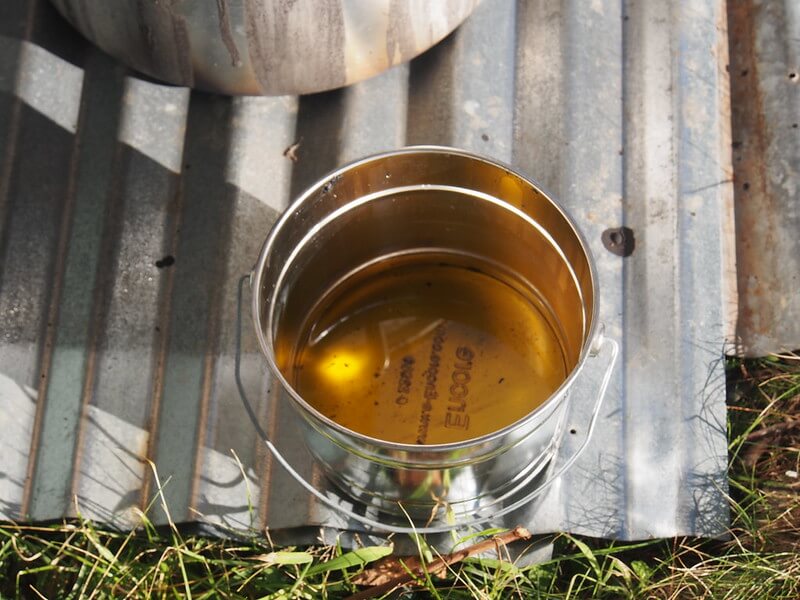Both greenwood and dry wood have pros and cons when used in carving. Dry wood is a popular option for most woodcarvers because its likelihood of cracking is lower because of lower moisture content. Green wood is easier to carve even for beginners and a preferred option when using hardwoods such as apple or alder.
One of the major downsides to carving greenwood is cracking/splitting as the carving dries. Whether it is a spoon, bowl, and other greenwood carvings, greenwood carvings are prone to cracking as they dry up. How do you keep green wood carvings from splitting?
You can use several methods to keep green wood carvings from splitting/cracking. You can use a plastic bag, pentacryl, dishwasher water detergent, or boiled linseed oil. All these methods help slow down the drying time of wood carvings to ensure they do not check over time.
How to Keep Green-Wood Carvings from Splitting/Cracking
1. Use a Plastic Bag
The use of plastic bags to slow down the drying process of wood carvings is not new. It is based on various older traditions where wrappings were used to slow down moisture loss. The plastic bag method is better at controlling the drying out process of a wood carving by precisely limiting the amount of air in contact with your project and limiting the amount of moisture escaping from your project.
In this method, find a plastic bag big enough to fit your wood carving project. I would advise you to choose a transparent plastic bag that will indicate the process via the amount of condensation forming on the bag’s surface.
Put your wood carving project into the plastic bag and seal the mouth of the bag tightly. The air inside the bag will take up some of the moisture present in your greenwood carving. This will appear as condensation on the plastic bag. Every 24 hours, reverse the bag and put the bowl back in. After a couple of weeks, if there is little to no condensation in the bag, unbag the carving and leave it in a dark spot for another couple of weeks.
Once done, your greenwood carving should have lost enough moisture without cracking. This is also time to introduce it to a drier atmosphere as its the final stage to dry out to equilibrium.
2. Use Pentacryl
Pentacryl is the best wood stabilizer for wood around, and it has a track record to prove it. Woodworkers have long used Pentacryl to keep green wood from cracking, checking, or splitting as it dries up. Pentacryl works by displacing water in greenwood to prevent shrinking and reduce cracking and splitting in wood.
Pentacryl can speed the drying time of green wood by 30% because it displaces water. Your greenwood carvings dry more quickly and evenly without adverse effects like cracking. It also acts as a lubricant while carving and does not stain wood or affect wood carving finishing.
For pentacryl, the recommended of application is to totally immerse a wood carving or project in a container full of pentacryl. Depending on your wood carving project, please select a suitable container that will totally immerse it in pentacryl. Apart from immersion, you can also brush or spray a wood carving project.
- If you’re looking to carve green wood over some time, brushing is the preferable option. After you finish carving for the day:
- Brush repeated coatings of pentacryl until the wood cannot absorb any more.
- Wrap the wood carving project with a dampened cloth and put it in a plastic bag.
- Repeat the process each day after carving, and when the carving is completed, periodically apply pentacryl until the wood can not absorb any more.
3. Use Boiled Linseed Oil (BLO)
Linseed oil, also called Flax oil, is a yellowish to colorless oil obtained through pressing dried and ripened seeds of the flax plant.

Linseed oil has long been used as a wood finish. Boiled linseed oil (BLO) is preferred to regular linseed oil due to its faster absorption. Regular linseed oil takes two to three days to dry and about five coats to protect a carving. However, boiled linseed oil takes a day to dry and penetrate the carving.
Applying boiled linseed oil is one of the easiest methods used by woodcarvers to protect greenwood from cracking. The powerful thing about boiled linseed oil is its penetrative abilities. When applied to a greenwood surface, wood fibers draw the oil deep inside and protect it both inside and on the surface.
First, smoothen the wood before you apply BLO. After that, apply BLO using a soft clean rag or a piece of steel wool. Apply in a circular motion across the wood grain and saturate it so it can penetrate as deep as possible. When the surface feels dry, sand and apply subsequent coats of BLO. On the final coat, do not sand the carving.
Why Does Green-Wood Split or Crack?
A freshly cut wood or greenwood, as its called, is always prone to splitting or checking over time. Splits and cracks in wood occur as the wood shrinks when drying.
Wood shrinks two times faster along with growth rings (radially) than it does across the rings (tangentially). This uneven shrinkage is what causes the wood to split when drying. To stop cracking, you need to slow down the drying process or use a wood stabilizer like Pentacryl to displace the water and stop cracking over time.
> Recommended Reading: Carving Greenwood vs. Dry Wood
Wrapping Up
Carving greenwood is easy and beginner-friendly. However, cracking is, unfortunately, one of the disadvantages you will encounter. Cracking can be minimized by using the methods I outlined above. Carving a softer greenwood like poplar is will also reduce the likelihood of cracks. Some exotic woods like Teak would also be less likely to crack because they are very oily.